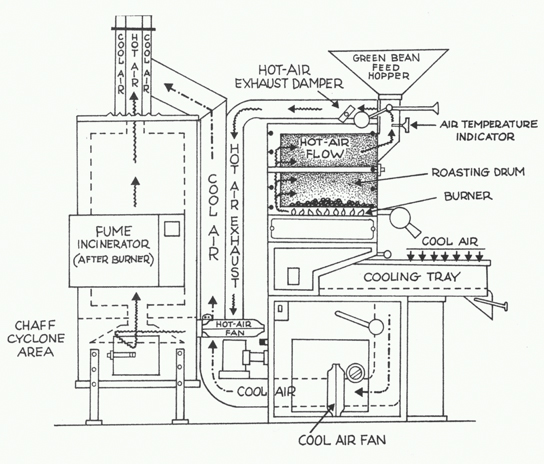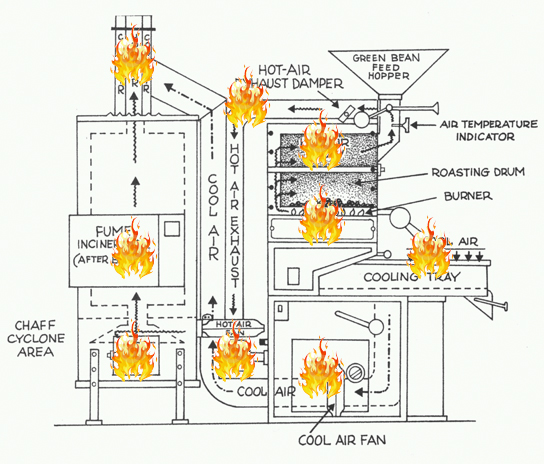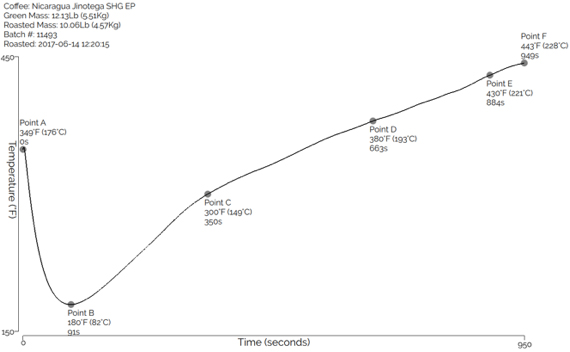SCA Roasting Foundation
Study Guide, v1.0
Press "h" for keyboard shortcuts for this presentation
How to use this guide?
Print a copy of the notes
As you progress through the slideshow, fill in the blanks and solve the problems in the notes
Study your notes (including familiarizing yourself with the keywords)
Bring your completed notes to class and add to them. We'll be handing out the same notes in class!
Pass the test like a boss
Know thy roaster!

Three Burner Types
Atmospheric burner (gas burner)
Electric burner (like toaster oven)
Infrared burner (ceramic plates in BBQ grill)
Three Burner Types
Atmospheric burners are fast and responsive
This can be both good and bad; fast = easy to overcompensate
Three Burner Types
Electric burners are good below 12kg capacity
Slow to respond; are like steering a boat (think drift)
Three Burner Types
Infrared burners are energy-efficient
But also slow to respond. Gas heats another material (often ceramic) which in turn heats the environment.
Deidrich uses IR burners
Heat Transfer Methods
Convective
Conductive
Radiative
Convective
- Air as a medium or vehicle
- Most common transfer method in drum and air roasters
- The greater the temp difference between air and bean greater the transfer (potential)
Convective
Conductive
- Physical contact + temperature gradient
- Common cause of roast defects
- Temperature gradient inside bean
- Water content is critical
Convective
Conductive
Radiative
- Electromagnetic radiation (same as the sun)
- Some visible, some not
- Example: light from heat source, heat felt near a heat source
- Metal in roaster acts as a battery, storing energy as heat
- Especially the drum, backplate, and faceplate
Roasting Plant Safety
Three areas of concern:
Fire
Ventilation
Personal safety
- Create an emergency plan ahead of time
- Discuss the plan with everyone
- Create a cleaning + maintenance plan
- Regularly review procedures and plans
Safety Definitions
Fire Safety
Keeping your equipment, staff, products, and customers safe from fires.
Safety Definitions
Fire Safety
Ventilation Safety
Keeping your staff and customers safe from dangerous gasses and airborne particles (such as dust from green coffee or micro-fibers from jute bags).
Safety Definitions
Fire Safety
Ventilation Safety
Personal Safety
Keeping your self and your staff safe and free from harm or injury
Roaster fire hazards

Roaster fires
What to do:
- Stay calm
- Shut off gas (or heating element if electric)
- Shut off exhaust fan and close exhaust damper if possible
- Keep drum rotating
- Use water hose or quenching system if you have it (pulse 10 seconds on, 10 seconds off)
- Don’t eject beans
- Monitor the bean temp
- If you have an afterburner, leave it on
- If stirer arms are on, turn them off
- If cooling fan is on, turn it off
- Extinguish any fire outside drum
- Don't drop the beans until the BT is below 93°C/200°F
- Call the fire department when necessary
Oxygen is a fuel source. By opening either door to the roaster drum, you will inject more oxygen into the drum.
If the beans in the drum are on fire, keep them in the drum where the fire is contained (the drum is fireproof).
List adapted from Marty Curtis's list
Personal Safety Concerns
Four areas of concern:
- Green coffee storage
- Roasting
- Packaging, production
- Shipping
What are some concerns in these areas?
Fire Classifications
- Class A Ordinary items (wood, paper, plastic, rags)
- Class B Flammable Liquids
- Class C Electrical equipment
Roaster Cleaning & Maintenance
- Remove chaff often (fuel source for fire)
- Know where chaff collects in your roaster
- At least daily, more for “chaffy” beans
- Keep ducts clear/clean (creosote & chaff)
- Keep moving parts lubricated (food grade grease)
- Follow manufacturer’s manual and recommendations
Physical changes in the bean
- Dries out
- Progressively darkens
- Becomes increasingly brittle
- First Crack
- Size can increase 30 - 100%
- Second crack
- Eventually oil seeps out (especially beyond second crack)
- Sometimes get divots (can be a roast defect)
- Rapid cooling (≤ 4min) to halt chemical reactions (changes)
First Crack and Second Crack
- Every successful roast has a first crack
- First crack is the result of rapid release of pent-up vapor/steam pressure and CO2
- Not all roasts reach second crack (operator’s preference)
- Exothermic flashes as escaping heat affects environment
Roast Data
Measurements that can be collected from green and roasted coffee:
- Green: batch weight
- Green: bulk density
- Green: volume
- Green: screen size
- Green: moisture content (acceptable range for Specialty?)
- Roasted: color
- Roasted: weight*
- Roasted: bulk density*
- Roasted: volume*
Cupping data should be associated with roast profile for post-roast analysis.
*Calculate percent changes for these attributes
Label the following on a typical roast profile
Charge, Turning Point, Color change: green to yellow, First crack, Second crack, Roast End

Roast Progression
Generally speaking:
Lighter roasts highlight (preserve) acidity, enzymatic flavors/aromas
Darker roasts emphasize chocolatey, nutty, bitter flavors/aromas
Why?
As the roast progresses, organic acids are broken down.
Also, with darker roasts, the Maillard reaction has more time to react. The flavors most associated with the Maillard reaction are chocolatey, nutty, and bitter flavors and aromas.
Temperature Midway Point ≈ 75 Agtron
- New concept
- Generates easy color to work/train with
- Not meant to be a standard or a sweet spot regarding end product

End of presentation